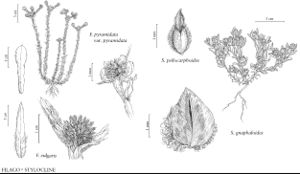Stylocline psilocarphoides
Leafl. W. Bot. 4: 185. 1945.
Plants 1–8 (–18) cm (branches ± leafless between proximal forks). Leaves ± acute, mucronate, longest 8–18 mm; largest capitular leaves elliptic to spatulate, 3–10 × 1–2 mm. Heads in strictly dichasiform arrays, ovoid, largest 3.5–5 × 2.5–4 mm, thinly lanuginose. Phyllaries 0, vestigial, or falling, ± subulate, mostly 0.1–0.5 mm, unequal. Receptacles ± cylindric, 2–3 mm, heights 5–8 times diams.; scars concentrated proximally and distally, raised, peglike. Pistillate paleae: longest 2.8–3.3 mm, winged distally; wings oblanceolate to oblacrimate, widest in distal 1/3 of palea lengths; bodies cartilaginous; outermost paleae open, concave. Functionally staminate florets 2–5; ovaries ± vestigial, 0.1–0.3 (–0.4) mm; corollas 1.1–1.7 mm (lobes usually 5). Cypselae 1.1–1.6 mm, obcompressed; pappi: staminate rarely 0, usually of 1–3 smooth bristles 1.1–1.5 mm.
Phenology: Flowering and fruiting Feb–Jun.
Habitat: Open, relatively stable, often granitic, sandy to gravelly desert soils, often at rock bases, under shrubs
Elevation: 100–2000 m
Distribution

Calif., Idaho, Nev., Oreg., Utah.
Discussion
Stylocline psilocarphoides is centered in the Mojave and western Great Basin deserts and extends to southeastern Oregon, southwestern Idaho, and through the western Sonoran Desert nearly to Mexico. Disjunct collections from southern Arizona in 1876 and 1941 are likely to be either labeling errors or from introductions that did not persist.
Circumscription of Stylocline psilocarphoides became clearer after recognition of S. intertexta and S. masonii (J. D. Morefield 1992b).
Selected References
None.
Lower Taxa
"broader" is not a number."longest" is not a number.
